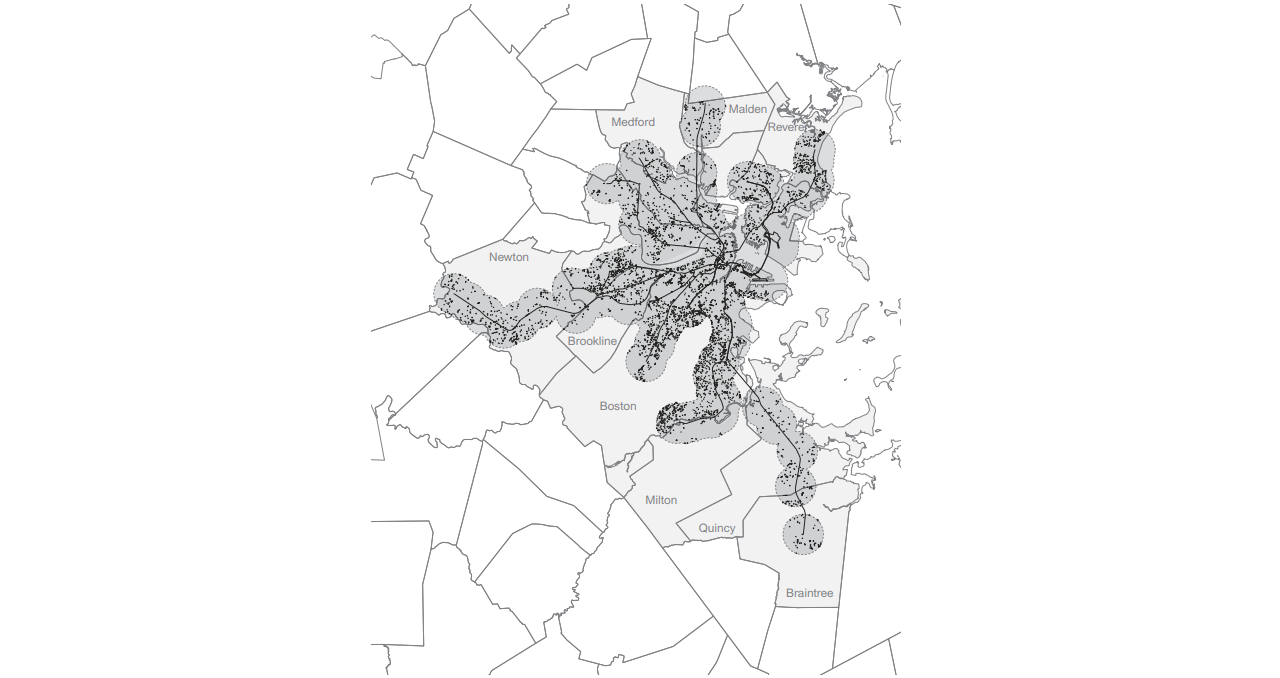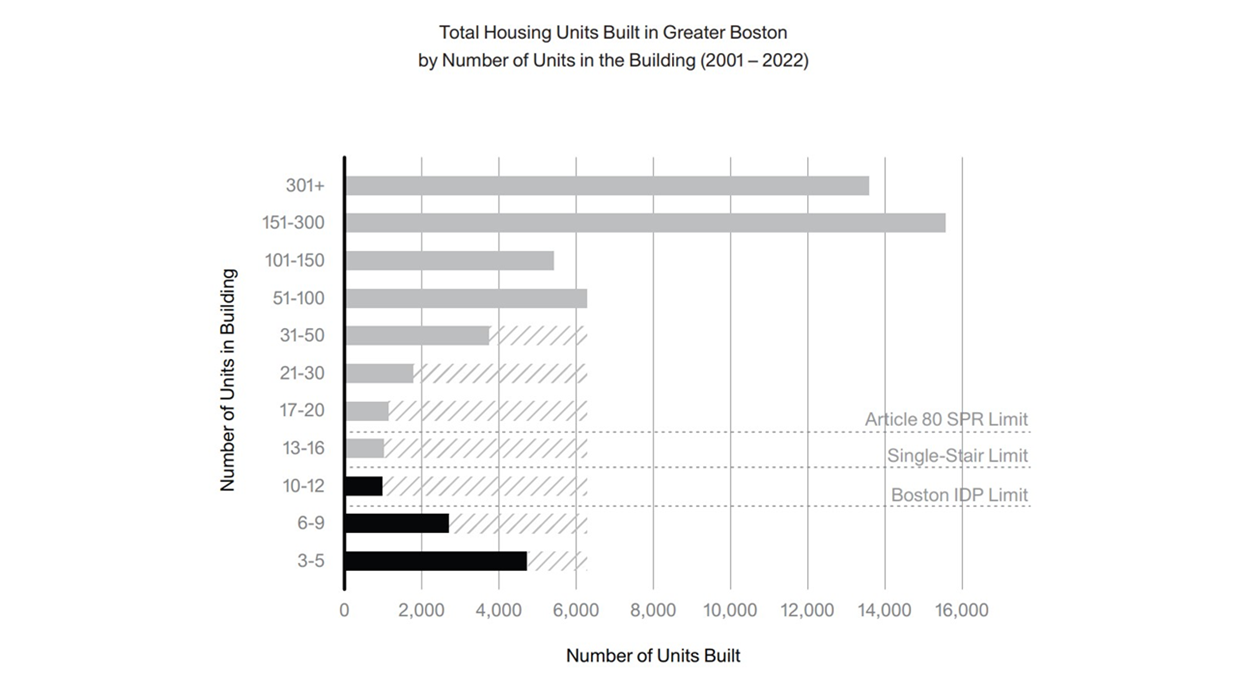Upzone Update: Next Steps on Single Stair
By Luc Schuster
July 7, 2025

Caption: Map of the 4,955 small to medium sized parcels within 0.75 miles of rapid transit that could support significant new housing with single-stair reform. From Legalizing Mid-Rise Single-Stair Housing in Massachusetts.
The U.S. tax code has grown into a sprawling maze of credits and deductions, far more complex than any single policymaker ever intended. Once added, provisions tend to persist long past their usefulness, rarely undergoing deliberate review or repeal. Moneyed interests can navigate the system with relative ease, while those with lesser means and smaller scales have a much harder time. Increasingly, the same critique applies to our building code.
While zoning governs what homes can be built where, the building code shapes how they are built, influencing cost, design, and feasibility. Most states base their codes on the International Building Code (IBC), a model set of safety and construction standards developed by the non-governmental International Code Council. States typically adopt the IBC with amendments, and even small deviations can significantly affect what gets built. Like with the tax code, steadily adding building code requirements without eliminating ones rendered obsolete by technological advances (like fireproof material advances and sprinkler systems) can quietly hold us back. Despite its sweeping influence, the IBC operates far outside typical democratic channels: it holds the same federal tax status as the NFL and is developed with minimal input from architects, planners, or elected officials, giving a small group disproportionate power over how our built environment evolves.
Massachusetts’ sluggish adoption of recent IBC updates concerning mass timber use offers a cautionary example. Mass timber is an engineered product that has greater load-bearing capacity than pure wood and is more sustainable than concrete and steel. The 2021 IBC introduced new construction types allowing mass timber buildings up to 18 stories, promising a more sustainable and cost-effective option for dense housing. States like Oregon, Washington, and Virginia moved swiftly to adopt these changes by 2021 or 2022. Massachusetts didn’t follow suit until late 2024, years after the national model was released.
Now, Massachusetts can take another step in updating its building codes: reconsidering the requirement that mid-rise buildings above three stories have two means of egress (i.e., staircases). As we move forward with this process, we should avoid repeating past mistakes by acting promptly to modernize codes that no longer reflect the realities of construction technology and housing needs.
In October 2024, Boston Indicators commissioned the Joint Center for Housing Studies and the design firm Utile to study this issue in a report titled Legalizing Mid-Rise Single-Stair Housing in Massachusetts. It found that in Greater Boston, very few units are created in buildings with more than nine but fewer than 30 units, in part because the two-staircase requirement drives up costs, reduces livable space, and limits quality design. This threshold is also often where inclusionary zoning requirements kick in.

Our report estimates that we could net upwards of 130,000 new homes in Greater Boston using single-stair designs on undeveloped small to mid-sized parcels within 0.75 miles of transit. Much of this would be built in dense urban parts of the state where small parcels are currently underutilized, places like Boston, Cambridge, Somerville and Gateway Cities.
The national process for revising the IBC is slow, limited, and most responsive to industry groups with specific financial stakes in reform—such as mass timber producers, the sprinkler industry, and single-family homebuilders. Without state action, we may not see the legalization of single-stair buildings until well into the 2030s. In fact, four-story single-stair buildings will not be included in the International Building Code (IBC) any earlier than 2027. Given that Massachusetts has recently operated anywhere from three to nine years behind the IBC (only adopting the 2021 IBC in 2024 and remained on the 2015 version until then), on our current trajectory it’s likely the state wouldn’t legalize five-story or taller single-stair buildings until sometime well into the 2030s. Choosing not to act now effectively endorses today’s restrictive land use patterns and low housing production, which are rooted in outdated views on apartments and multifamily living.
Reflecting this reality, a wave of state-level reform efforts has emerged, with several states passing single-stair reforms in under a year. Progress in Massachusetts has been slower, as is often the case, but State Senator Cronin and State Representative Kilcoyne have now filed companion bills to create a study commission charged with developing a building code amendment to allow single-stair apartment buildings up to six stories. The bill includes $250,000 for the study, which, interestingly, is roughly the cost of constructing a single extra stairwell. Advocates had considered several legislative pathways:
- Requiring the state’s Board of Building Regulations and Standards (BBRS), which adopts and modifies the IBC for Massachusetts, to revise the code and legalize single-stair buildings statewide;
- Requiring the BBRS to revise the code to allow (but not require) cities with sufficient fire capacity to opt into legalization;
- Creating a study commission to draft a code amendment for the BBRS to consider, without mandating its adoption.
To balance the need for urgency with respect for the BBRS’s technical expertise, the filed bill reflects the third, more measured study commission approach. And while Massachusetts is just beginning to consider this modest step, other states are already much further along:
State law directly legalizing single-stair designs
- Montana (Enacted in 2025). Allows single-stair buildings up to six stories with modern fire safety systems. The reform followed a 2022 housing task force recommendation.
- Connecticut (Enacted in 2025, but not yet implemented). Directs the state code commission to allow single-stair buildings above the current three-story cap in municipalities with adequate fire capacity. Final code language is still in development.
- Colorado (Enacted in 2025, with implementation beginning now). Colorado does not have a statewide building code, so this law instructs municipalities of at least 100,000 people to adopt code language allowing single-stair designs up to five stories.
State law enabling local opt-in
- Tennessee (Enacted in 2024). Rather than revising the building code statewide, Tennessee created single-stair code language that cities and counties can opt into. Passed in one session without a study commission. Knoxville, Jackson, Memphis, and Nashville have all adopted local ordinances under the new law.
State study commission
- Washington (Study law enacted in 2023; code change proposal now pending). A study group led by the Washington Association of Building Officials met in late 2023 and has now filed legislation for a local opt-in approach following the study group’s recommendations.
- Minnesota (Enacted in 2023). Funded a $225,000 study with findings due by late 2025. Separately, a technical advisory group has recommended raising the height limit to four stories, and this is on track for inclusion in the next building code update for 2026.
- California (Enacted in 2023, with recommendations due by January 1, 2026). Passed within six months. The State Fire Marshal must deliver reform recommendations to the legislature by January 2026.
- Virginia (Enacted in 2024, with recommendations likely in 2025). A working group issued initial options in 2024 and recommended forming a follow-up group to draft code reform language.
- Oregon (Enacted in 2023, but reform recommendation rejected). Legislation directed the Building Codes Structures Board to adopt a reform. A compromise proposal allowing four stories with local opt-in is on track to become effective on October 1, 2025.
- New York (Enacted in 2024). Calls for a study on applying New York City’s single-stair model statewide. Findings are due by July 2026.
Other states, including Texas, have single-stair bills still moving through their legislatures.
Back in Massachusetts, on Wednesday, June 25, the Joint Committee on Housing held a public hearing on a slate of housing production bills, including the single-stair study commission bills filed by Senator Cronin and Representative Kilcoyne. Several people, including some national experts, testified in support of the bills, and it will be interesting to see if and when the legislature takes this small step toward supporting the construction of more missing middle housing that our region so desperately needs.
Other useful resources on single-stair reform
- Legalizing Mid-Rise Single-Stair Housing in Massachusetts, our October 2024 report with the Joint Center for Housing Studies and Utile.
- Small Single-Stairway Apartment Buildings Have Strong Safety Record, an analysis by the Center for Building in North America for Pew analyzing cost savings and the safety track record of single-stair reforms in New York City and Seattle.
- The Center for Building in North America, a nonprofit research and advocacy organization analyzing building codes and standards and advocating for reforms to enable greater housing construction, improved design flexibility, and greater safety. The website includes a reform tracker for single-stair and elevator code reforms.
NEWS AND EVENTS
Andrew Brinker and Catherine Carlock of the Boston Globe offer an analysis of why Boston’s building boom has gone cold: “Materials costs for multifamily buildings have jumped more than 40 percent since the start of 2020. Interest rates on construction loans have soared. And the investors who typically finance housing developments now demand higher returns, meaning projects need to make a bigger profit to get built at all. It is not uncommon for apartment towers in Boston to cost $1 million a unit these days.” They point to other factors too. One debate: How big a factor is inclusionary zoning?
Andrew Brinker also shares tough news about housing vouchers.
Greylock Federal launched a loan program for accessory dwelling units in Berkshire County.
Massachusetts State Senator Will Brownsberger offers a cogent analysis and overview of the Commonwealth's housing policies in his podcast.
Pioneer Institute hosted a webinar on housing policy and the housing market.
Check out the 2025 State of the Nation’s Housing, as a report and a recorded forum.
Come to the Launch of the Massachusetts Zoning Atlas, Friday, July 18 at noon, at Suffolk Law, Sargent Hall, 5th Floor, 120 Tremont Street, Boston. RSVP at this link. Explore the Massachusetts Zoning Atlas at this link.
MassINC Policy Center released a report on the construction workforce for housing and clean energy.
